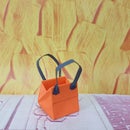Introduction: Easy Cardboard Running Horse
You can find cardboard just about anywhere and for cheap, if not free. It’s versatile, easy to use, and an excellent teaching tool. At my home and school this the first thing that I like to give to the kids so that they get the opportunity to embrace STEM activities with a simple and inexpensive material: cardboard.
In this Instructables, I'll share how to make a Cardboard Horse and make it run with the help of Power Of Science, without any battery or wheels."This is my opening lines in the class before I start with this activity"
Time Required: 25 min
What: Horse made out of cardboard which will move with the help of fluid pressure.
Why: Hands-on fun activity on liquid pressure.
How: Read-along...
Step 1: Things We Need:
1) Cardboard 30cm*30cm
2) Glue Gun and Glue Sticks(2sticks) Amazon.com // Amazon.in
3) X-ACTO knife Amazon.com // Amazon.in
4) 2 10 ml Syringe Amazon.com // Amazon.in
5) 1 foot of clear plastic tubing that fits the syringe tips Amazon.com // Amazon.in
6) A pair of Scissors Amazon.com // Amazon.in
7) 1 Toothpick piece Amazon.com // Amazon.in
8) Straw, One, 2cm piece
9) Pen/Pencil for marking
10) Red acrylic color (Optional)
11) A glass full of water
Step 2: Trace >> Transfer >> Cut:
1) Making Template:
Draw an outline of a horse on paper and cut it with the help of scissors.
If you are not good at drawing like me, then GOOGLE for "Horse Outline". Once you find your perfect horse (prefer black outline with white background) sketch, download and save it. Now, open the image and turn up your laptop/desktop/tablet screen to the maximum brightness and place paper on the screen. You just need to trace the black outline. Cut it with scissors and the template is ready.
2) Transferring the template:
Place the horse cutout over the cardboard and trace the outline with a pen/pencil.
3) Now, trace the outline with the X-ACTO knife and carefully remove the horse wen done.
4) Using this cardboard horse as a template cut another horse.
Step 3: Horse on Its Feet:
1) Cut both the horses from the center part of their body so that each horse is now in two parts.
2) Cut a 30cm*2cm cardboard strip. Roll it over a pen/pencil to make the strip flexible.
3) Using hot glue, stick the cardboard strip along the perimeter of one of the horse body leaving the legs of the horse.
4) Stick the parts of the second horse over the respective parts on the first horse.
The Horse is ready and now it can stand on its feet.
Step 4: Adding Hydraulics:
1) Select one of the 10 mL syringes and glue a 2 cm straw on the top of its plunger. This will be the “fixed syringe”.
2) Make a small hole 1 cm above the front leg just to fix a toothpick across the horse's body. While passing the toothpick across make sure that it goes through the length of the straw. The toothpick should now act as stops to keep the fixed syringe from being pulled completely out of the syringe at the same time helping it move freely.
3) Push the plunger of fixed syringe so that there’s no air in the syringe. Use a small scrap of cardboard as gussets to attach the top and bottom parts of the horse. Glue it firmly. The tip of the syringe should out from the back of the horse. Cut a small tail for the horse and fix it with glue.
4) Attach the plastic tubing firmly to the tip of the second 10 mL syringe. This will be the “free syringe”. Pull the plunger out until it is fully extended. Fill the syringe and tube completely with colored water. (If there are air bubbles, try flicking the syringe or tube with your finger to get them to rise, and then top off with more water as necessary).
5) Attach the other end of the plastic tubing to the tip of the fixed syringe. Glue the ends if necessary.
Step 5: Making It Run:
Push on the plunger of the free syringe. What happens? Pull-on the plunger. What happens now?
You will notice that as you push the plunger the two parts of the horse opens up in inverted V fashion., When the horse is up on its feet, this opening and closing motion along the friction of the surface make the horse move forward.
Step 6: What's Going On?
When you push on the plunger of the free syringe, it applies pressure on the water in the syringe. Now, since the water is confined and incompressible, Pascal’s principle comes into play, telling us that the pressure is transmitted undiminished to all parts of the water and to the walls of its container. Since the plunger of the fixed syringe at the other end of the tube forms part of the “container” for the water and is the only part of the container that can expand, the pressure causes the plunger in the fixed syringe to move. The reverse of this is also true for this system, ie when you pull the plunger of the free syringe. Additionally, as you can observe, each plunger moves the same distance.

Participated in the
Cardboard Speed Challenge











